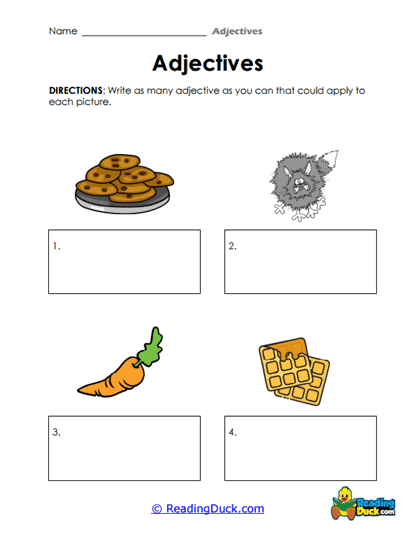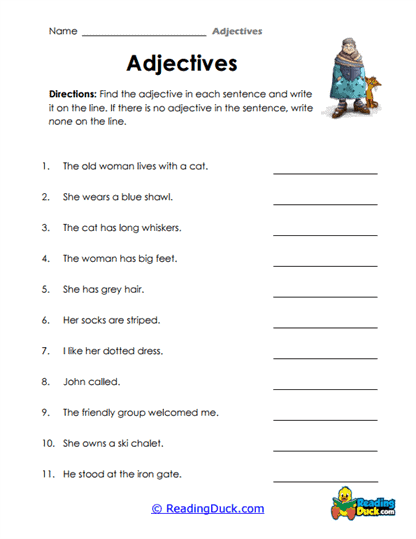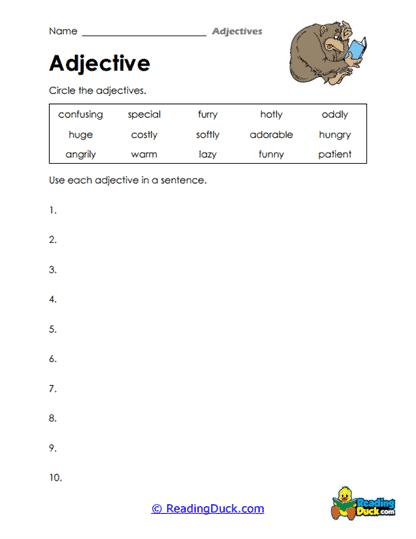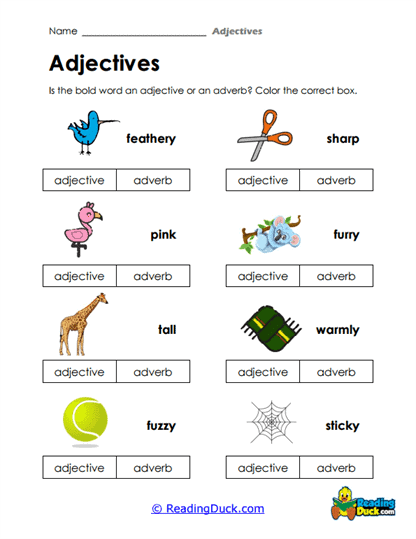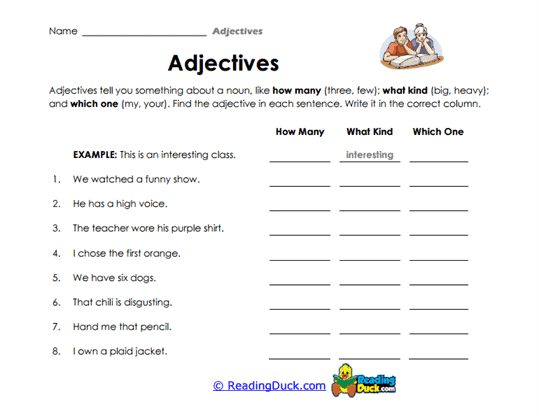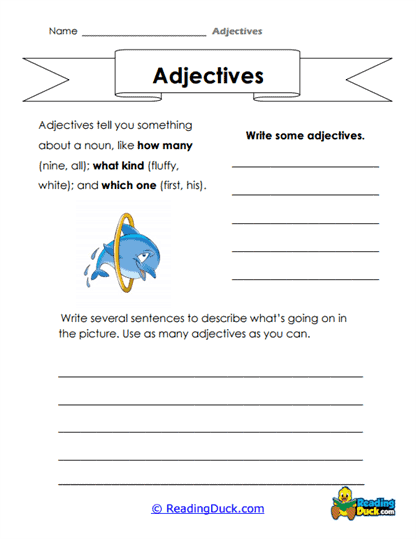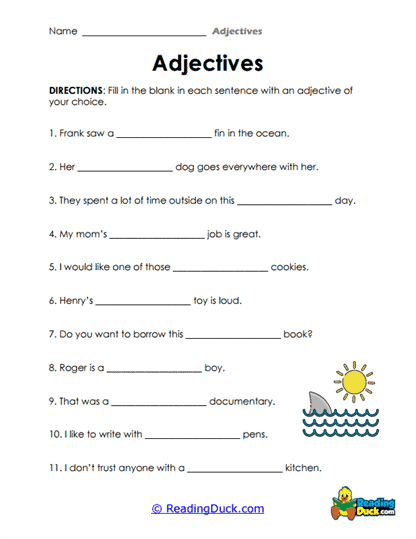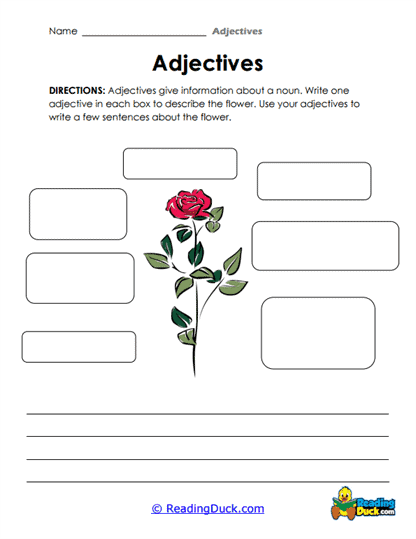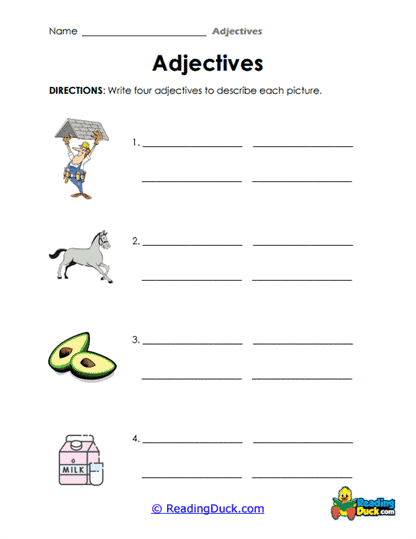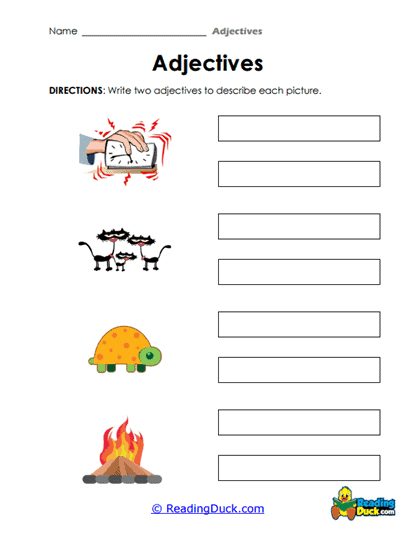Adjectives Worksheets
About Our Adjective Worksheets
The Adjectives Worksheets collection is an invaluable resource within the Grammar category under the Skills section. Designed to help students develop a solid understanding of adjectives, these worksheets offer a variety of activities that strengthen their grasp of descriptive language, making their writing and speaking more vivid and engaging. By focusing on adjectives, students can significantly improve their sentence structure and the overall quality of their communication. This collection provides a structured approach to learning grammar, allowing students to identify, understand, and effectively use adjectives in context.
The worksheets are presented in PDF format, making them easy to view, download, and print. Additionally, each worksheet comes with a downloadable answer key, facilitating the review process for both educators and students, and ensuring that learning can take place independently or in the classroom.
Understanding Adjectives: The Power of Description
Adjectives are words that modify or describe nouns and pronouns, adding detail and specificity to sentences. They provide answers to questions such as "What kind?" "Which one?" and "How many?" By using adjectives, students can transform simple sentences into more complex and descriptive expressions, enhancing both their writing and speaking abilities. Understanding adjectives begins with a clear definition and the various ways they function within sentences.
Definition of Adjectives
An adjective describes or limits a noun by providing additional information. Adjectives can describe a wide range of qualities and attributes, including size, color, shape, quantity, and emotions.
- Example 1: "The blue sky stretched endlessly."
- Example 2: "She bought three books from the store."
Types of Adjectives
- Descriptive Adjectives: These adjectives provide information about the qualities or characteristics of a noun. For instance, "The tall building" uses "tall" to describe the height of the building.
- Quantitative Adjectives: Quantitative adjectives tell us about the quantity of the noun. Words like "some," "many," "few," and "several" fall into this category. For example, "She had many friends."
- Demonstrative Adjectives: These adjectives point out specific nouns and include words like "this," "that," "these," and "those." For example, "I prefer these shoes."
- Possessive Adjectives: Possessive adjectives indicate ownership or relationship. Examples include "my," "your," "his," "her," "our," and "their." For instance, "This is my pen."
- Interrogative Adjectives: These are used in questions to inquire about nouns. For example, "Which book is yours?"
- Comparative and Superlative Adjectives: Comparative adjectives compare two items or people (e.g., "smaller," "bigger"), while superlative adjectives describe the highest degree of a quality among three or more (e.g., "smallest," "biggest").
Comparative Example: "She is taller than her sister."
Superlative Example: "He is the tallest in the class."
The Role of Adjectives in Sentences
Adjectives typically precede the nouns they describe, but they can also appear after linking verbs such as "is," "seem," or "appear." When used after linking verbs, adjectives describe the subject of the sentence.
- Example 1: "The flower is beautiful."
- Example 2: "He seems confident about his presentation."
Mastering adjectives allows students to add layers of meaning to their sentences, resulting in richer, more detailed communication.
Strategies for Teaching Adjectives to Students
Educators can introduce adjectives in a variety of engaging ways that cater to different learning styles. By using a range of techniques, teachers can help students fully understand and master the use of adjectives.
- Contextual Learning: Start by presenting students with simple sentences lacking adjectives. Then, have them add descriptive words to make the sentences more interesting and detailed. For example, change "The dog barked" to "The fierce brown dog barked loudly." This shows students how adjectives enhance writing by adding more detail.
- Adjective Word Walls: Create a classroom wall filled with adjectives, grouped by type, to serve as a reference. Students can add new adjectives they encounter in their reading or lessons, and refer to the wall when writing.
- Adjective Exploration through Reading: Use engaging books or short stories filled with rich descriptions. As students read, have them identify adjectives and discuss how they contribute to the overall imagery and understanding of the text. This reinforces how adjectives function in real-world writing.
- Comparison Exercises: Teach comparative and superlative adjectives by using everyday objects. For example, have students compare classroom items like pencils, books, or chairs. Ask questions like, "Which is taller?" or "Which is the smallest?" This makes learning interactive and helps students understand how adjectives change based on context.
- Descriptive Writing Prompts: Provide writing prompts that encourage students to use adjectives. Prompts such as "Describe your favorite place" or "Write about a magical creature" can inspire students to use rich descriptive language and practice using a variety of adjectives.
How Adjectives Improve Reading, Writing, and Speaking Skills
Mastering adjectives significantly enhances students' ability to communicate effectively in all forms of language—reading, writing, and speaking.
- Improving Reading Comprehension: Understanding adjectives helps students visualize the descriptions in a text. Adjectives provide key details that bring a story or piece of information to life, helping students form mental images and improving comprehension.
- Enhancing Writing Skills: Using adjectives allows students to create more vivid and interesting writing. Descriptive writing that incorporates adjectives is more engaging for readers, whether in creative writing, essays, or reports.
- Boosting Speaking Confidence: In spoken language, adjectives enable students to express themselves more clearly and descriptively. Whether telling a story or giving a presentation, adjectives help speakers paint clearer pictures and convey specific details that might otherwise be overlooked.
Engaging Activities to Reinforce Learning
To further support the understanding of adjectives, educators can introduce a variety of activities that make the learning process more enjoyable and interactive. These activities can be applied in both traditional classroom settings and homeschool environments.
- Adjective Scavenger Hunt (Grades 1-5): Organize a scavenger hunt where students must find objects that match specific adjectives. For example, ask them to find something "soft," "red," or "tall." This activity reinforces adjective usage and encourages students to think critically about how adjectives describe real-world objects.
- Adjective Art (Grades 2-4): Have students draw a picture based on a series of adjectives provided by the teacher. For example, the teacher might describe a "blue, small, round" object, and students would create an illustration based on that description. This visual activity links adjectives to tangible characteristics.
- Adjective Charades (Grades 3-6): In this variation of the traditional charades game, students act out adjectives instead of nouns or verbs. For example, a student might act out the word "excited" or "tired," and the others guess the adjective. This activity reinforces understanding of adjectives through physical movement and play.
- Writing Descriptive Paragraphs (Grades 4-8): Assign students the task of writing descriptive paragraphs based on prompts that focus on adjectives. For example, ask them to describe a favorite place, object, or person using as many adjectives as possible. Afterward, students can read their paragraphs aloud and identify the adjectives they used.
These activities help reinforce the concepts presented in the worksheets and allow students to engage with adjectives in diverse and meaningful ways.
The Importance of Adjectives in Real-Life Communication
In summary, adjectives play a crucial role in enhancing communication. Mastering the use of adjectives allows students to describe the world around them more effectively, making their writing and speech richer and more detailed. Whether they are writing creative stories, crafting essays, or giving presentations, the ability to use adjectives skillfully is an essential part of language proficiency.
Beyond the classroom, the ability to describe things clearly is a vital skill in everyday life. From writing descriptive emails to giving precise directions or expressing feelings, adjectives help us communicate more effectively in personal and professional settings. Therefore, learning to use adjectives is not only important for academic success but also for real-world communication.
The collection of Adjectives Worksheets offers a structured approach to learning this important skill, ensuring that students gain the tools they need to describe, explain, and engage with the world around them in a more meaningful way.
